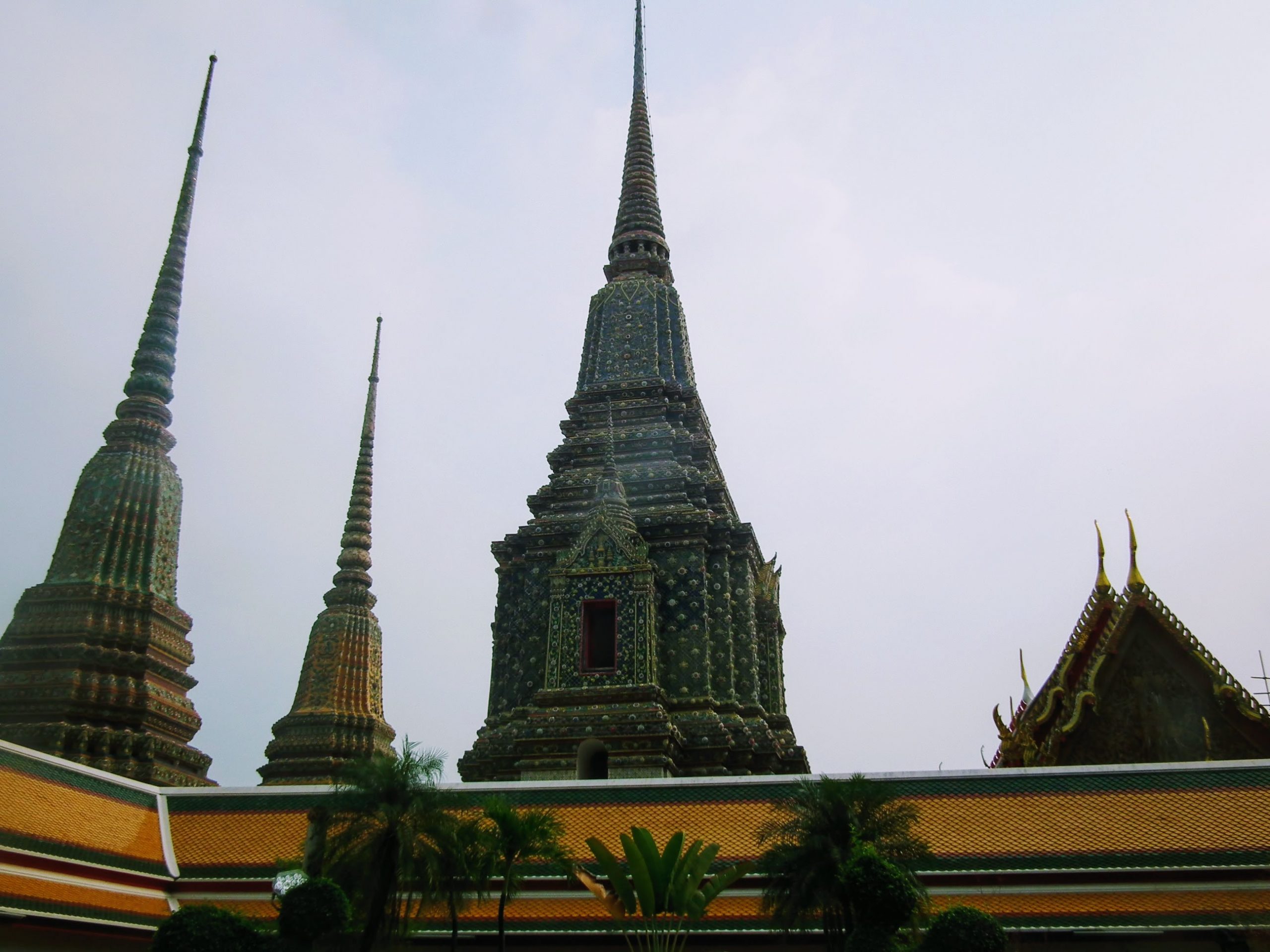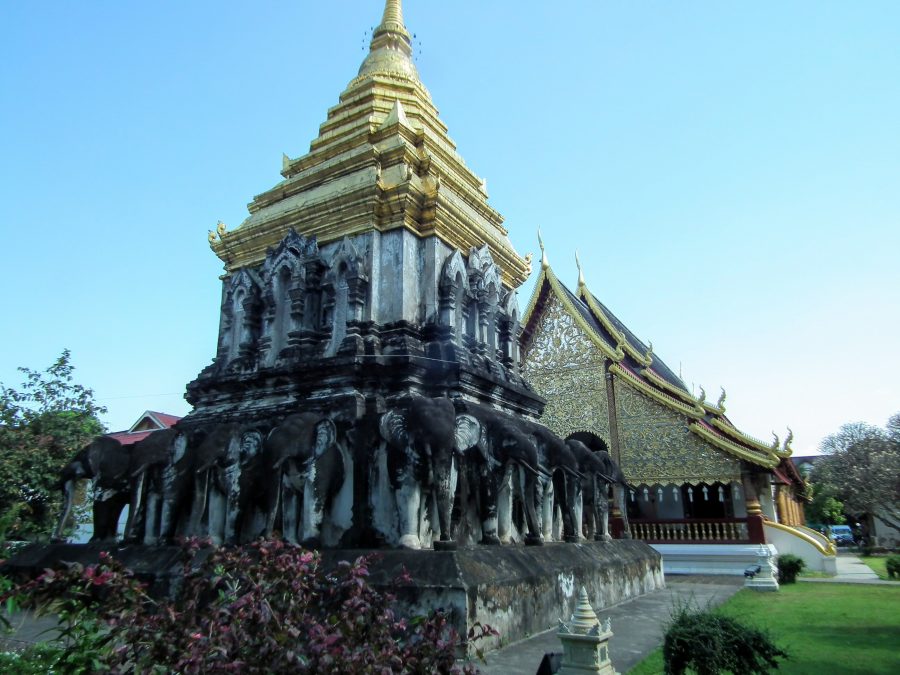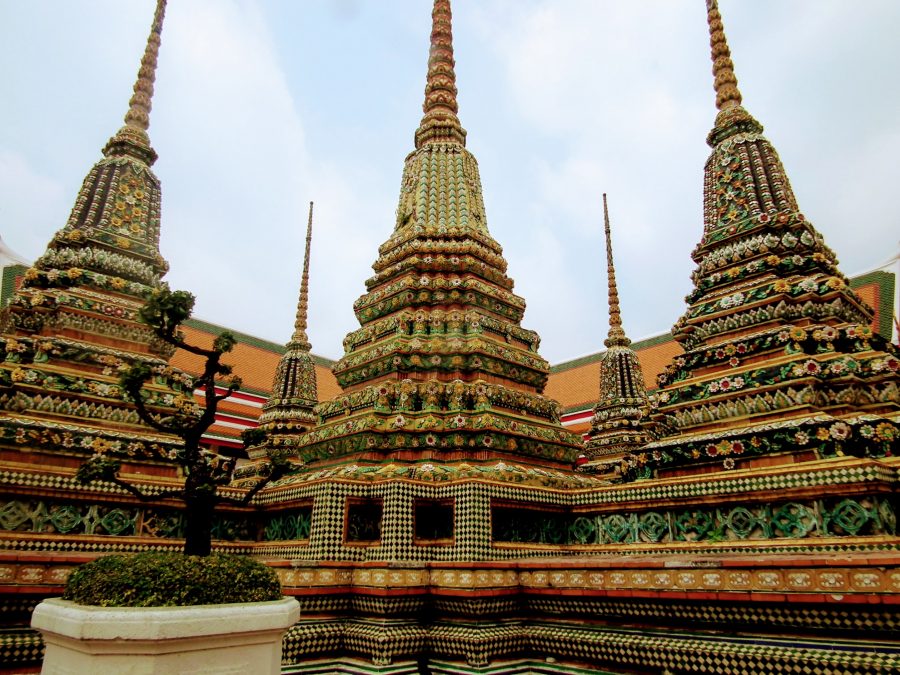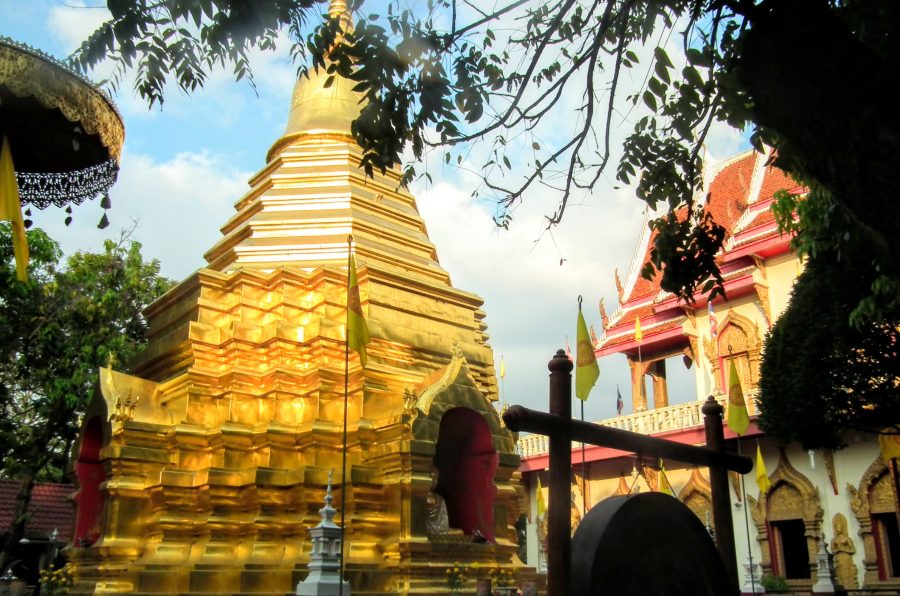
Stupas are universal throughout Asia. They are said to represent the burial mound the historical Buddha, Prince Siddhartha Gautama, ordered his disciples to erect when he died. Stupas have a variety of names depending on the country. In Thailand it is Chedi: stupa, (India), dagoba (Sri Lanka), chorten (Tibet), chedi or pagoda (Burma), t’ap (Korea), ta (China), tarp (Vietnam), thaat (Laos), sotoba (Japan), chandi (Java).
The architecture of the stupas throughout Asia also differ, but they are essentially developed from ancient burial mounds. They existed in India long before Buddha Gautama and can be found through various parts of the world including Europe and the Americas.
What they all have in common, however, is meaning; stupas represents the path to enlightenment and the potential for us to awaken to our true nature.

The shape of the Stupa reflects a seated Buddha in meditation, although some are so stylised it’s difficult to detect this specific meaning. The structure is divided in three parts; the base is the throne, where a meditator sits. In the centre is the bulging dome which reflects the Buddha’s body, and the base of the spire, the harmika, is the Buddha’s head.
In the foreword of the book, Buddhist Stupas in Asia: the Shape of Perfection, Professor Robert Thurman explains:
“Stupas… demonstrate the triumph of enlightenment’s wisdom over suffering’s ignorance. They are memorials… to the possibility of freedom from suffering for all beings. They signal the triumphal reality of a nature that enables beings to evolve to experience the ultimate fulfilment of perfect bliss, beyond death and unsatisfying life. Stupas stand as eloquent testimony to the higher purpose of life, beyond competing or struggling, getting or spending. Consciously or subliminally, they help turn people’s minds away from their frustrating obsessions and towards their own higher potential.”
Not all stupas are the same. However, the three principle elements are always present; the square foundation (throne), the dome (body), the harmika (head). Most stupas I saw in South-East Asia also have a spiral topped by a parasol.
The basic structure of the stupa reveals the path the enlightenment in accordance with Siddhartha’s teachings. One has to go a little deeper than standard buddhist literature to understand the true meanings; the true teachings are ethical, practical and metaphysical.
The square foundation of a stupa typically has three steps, traditionally representing the three refuges of buddha (enlightenment), dharma (teaching) and sangha (practice). Through these three jewels we learn to rid ourselves of the ten non-virtues:
However, when you remove religious dogma and apply rational sense in the form of hermetic alchemy, the three steps essentially reflect, thoughts, emotions and actions. It is the quality or the weakness in how we think, feel and behave that essentially shapes our character, our view of the world and ultimately how we experience life.
The four steps between the foundation throne and the dome are where the legs of the meditator would sit. They steps represent the four ‘dwellings of Brahma’ given in the Mettanisamsa Sutta. These four qualities are loving kindness, compassion, joy and equanimity are said to dissolve the bounds that constrain us and develop our capacity for new experiences.
The dome, or bumpa, in the centre of Thai chedis, represents the torso and upper body of the meditator and encompass the seven elements or qualities of enlightenment. Siddhartha said to reach enlightenment, practitioners must master certain qualities of mind, energy and living;
It is important to note that the first six qualities are states of mind that constitute the ability to be mindful in everything you do. This is the ultimate goal of initiates that intend to live a simple life and free the mind from the bounds of limitations.
It should be noted that the seven qualities of enlightenment are actually natural states of mind and promote balance. Social conditioning and busy lifestyles impede our ability to concentrate, still the mind and detach ourselves from emotional states that cause suffering.
Mindfulness, the seventh and ultimate quality of enlightenment, is achieved by practising and fine-tuning the five primary qualities and giving into to the rapture – which is an intense feeling of pleasure. The first time you experience this will feel like an overwhelming surge of energy vibrating through your body.
Giving into the rapture and allowing it to happen is the breakthrough needed to attain Nirvana. Having achieved this the buddha acquires powers and can live life in harmony knowing they will always be guided by the higher conscious.
This is represented by the harmika and conical spire at the top of the stupa. The harmika is the base of the spire and represents the head of buddha, or more distinctly the throat, third-eye, and crown chakras.
This final element of the structure represents the stage in which initiates master the qualities of the mind, body and speech. It is at this point where initiates enter the path of buddha nature without trying. They become a human being, not a human doing.
At this stage of development, initiates understand there is no concept of self, but a wholeness to which we are all inextricably connected. We are all consciousness and feed from the same ocean of consciousness. When a drop of water falls into the ocean, it becomes a part of the ocean.
Whatever you think, feel and act is a results of consciousness. Your consciousness as an individual is like a drop of water falling into the ocean of the collective unconscious.

When the mind enters these realms of awareness, you have the capacity to understand what others are thinking and know the past and future events of others. For the developed mind of a buddha or bodhisattva, these powers of the mind come naturally.
Chedis in Thailand typically feature a parasol with seven, eight or nine layers. The parasol indicates protection from negative thoughts and evil deeds directed at you by others. It is in the seventh to ninth stages of awareness that we develop an understanding of our true nature and see the truth emerge from the mirky depths of illusion.
You will sometimes find stupas capped by a sun, moon and jewel, representing wisdom (sun), compassion (moon) and jewel (awakening to true nature). In Thailand, this concept is more subtle. In the image below for example, the three qualities are reflected by a through tiered frame resembling a candle holder – candles in turn reflecting en-light-ment.
It’s not unusual for the five elements to feature in Asian symbolism. Chedis feature the five geometric shapes which symbolise the five elements of the cosmos and the human body; earth, fire, water, air and ether. Ether, the fifth element is the collective unconscious, or what Edgar Cayce called The Akashic Records.
The base of the stupa is square, representing the earth and the four cardinal directions – which in turn represent the four cycles of evolution that manifest as creation; generation (east), destruction (north), rebirth (west), maintenance (south).
In relation to our everyday lives, the four directions relate to the transformation of subtle energies into physical reality which is determined through your actions. How you behave through act, speech and thought creates your experience of life.
Another example of this is the triangle of manifestation which embodies thoughts, emotions and actions. Our thought and emotions compel us to take action, but it is how we behave and express ourselves that creates our experiences. Thoughts, emotions and actions are a continuous cycle that reinforce one another the more we program the belief.

The dome reflects the elements of water which in turn represents the primordial conscious which is full of potential. In terms of design, the dome is analogous of the vessel that harbours all life on our planet; womb, egg or seed.
In symbolism, water is also related to consciousness and associated with the sacral chakra which the ancients referred to as the seat of emotions. Emotions are what drive us to action and can overwhelm our mental state which in turn impacts how we feel. It is the conflict between thoughts and emotions that create the inner-struggles which eventually materialise as external struggles in our daily lives.
The spire represents fire which ignites our passions and compels us to act. Fire also represents wisdom that burns away ignorance, hate and suffering caused by the illusions we create in our mind.
At the top of Thai chedis is the symbol of air which reflects the unity between male and female aspect of nature, often represented by the Sun (male principle) and moon (female principle). In esoteric symbolism, air comes from water (female/emotions) and fire (male/thoughts) and is a continuous cycle in the transformation of energy as manifest experience.
The circle at the top of the spire reflects the law of impermanence – nothing is constant, everything always changes. Energy is always in a constant state of flux with no beginning and no end. At the tip of the spire is a solid ball which represents the jewel, which reveals the perfect state of a buddha in harmony with his surroundings – just as nature intends.
